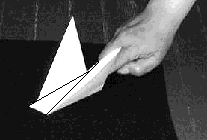
Here is a wonderful first model, requiring only 4 folds. Instructions, with alternatives given at various points, are:
1. Start with a square of paper. Fold on the diagonal. You and/or your students may decide to use other terminology. Possibilities include:
We offer these alternatives to demonstrate the variety of language possible. Let your students generate their own language. At this point you have an opportunity to pose questions on the relationship of the area of the original square and each of the subsequent triangles.
2. Take the triangle you got in the first step and fold it in half by bringing the two corners that are the farthest apart together. (What other ways could you 'fold the model in half?') You now have a new, smaller triangle. You can ask how much smaller and get into a discussion of linear dimensions versus area and symmetry.
3. Put your finger along the fold you just made and fold a single flap back over your finger. Unlike the previous folds, this step does not rely on definitive markers to execute the fold. This is often referred to as making the fold 'to taste'.
4. Turn the model over and make a fold on the side to match the preceding fold.
You now have the model. By tapping the folded 'spine', you make the creature
jiggle across the table. Image is a picture taken with a digital camera with
additional lines added for clarity.

You can apply the general strategies described above by asking the following questions: What kinds of shapes occur in folding this model? An appropriate answer would be 'squares and triangles'. What kinds of triangles are represented? Are the triangles similar? The answer is yes, but it may not seem that way because of our orientation to the paper. This relates to the question: What are the symmetries of the model as it is being folded and as a final model?
What is the wingspan of the final model in terms of the size of the original square?
The answer is the length of the diagonal of the original paper minus two finger-widths.
How big is the body of the wiggler?
The answer is not that definite. It is the height of a triangle with two equal sides, each the finger-width, but it depends on the sharpness of the angle. How about measuring everybody's wiggler and analyzing (get the mean, median, mode and distribution) of the results.
How does it work?
The folds in the paper give the paper some spring.
How exact does the folding need to be?
The answer is 'not very', but this is an opportunity for the students to experiment with very small and very large body constructions.